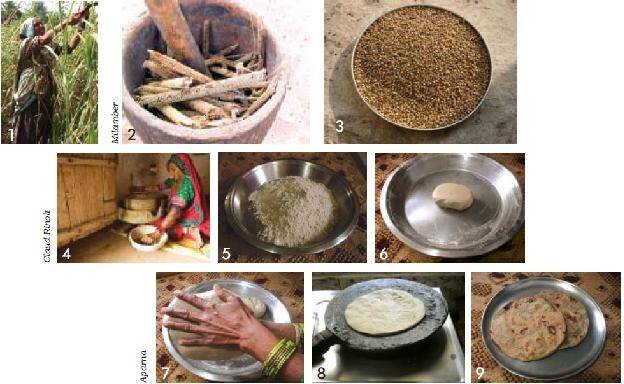GetStudySolution
Getstudysolution is an online educational platform that allows students to access quality educational services and study materials at no cost.
NCERT Solutions for class 5 E.V.S chapter 19 – A Seed Tells A Farmer Story
Back Exercise
Page No 175:
Question Tell:
- Are rotis made in your home? From which grains are they made?
- Have you eaten roti made from bajra or jowar ? Did you like these?
Answer:
Disclaimer: This question has to be answered by one’s own observation. Considering this, the answer to the same has not been provided.
Question Find Out and Write:
- In your house what is done to protect grains and pulses from insects?
- Which are the different festivals related to farming, celebrated in different seasons? Find out more about anyone such festival and write in your notebook –
The name of the festival, in which season is it celebrated,in which states of India, what special foods are made, is it celebrated only at home with the family, or together with many people.
Talk to the elders in your family and find out if there were some special foods cooked earlier that are not cooked any more?
Find out about the crops – cereals, vegetables, pulses – that are grown in your area. Of those, is there anything that is famous across the country?
Answer:
Disclaimer: This question has to be answered by one’s own observation and by gathering information. Considering this, the answer to the same has not been provided.
Page No 177:
Question Discuss:
- The bajra seed saw differences in the way Damjibhai and Hasmukh did farming (for example, in irrigation, ploughing, etc). What were these differences?
- Hasmukh said, “With profits from our fields, we can progress.” What is your understanding of ‘progress’?
Answer:
- The following table lists the differences in the ways of farming of Damjibhai and Hasmukh.
Aspects
Damjibhai
Hasmukh
Irrigation
Rain water or river water
Electric motor
Ploughing
Bullocks
Tractor
- In my understanding progress means the development of a person with the society, country or world he lives in.
Disclaimer: This is a sample answer. The answer of the students can vary from this. Also, the answer of two students can vary from one another. However, the emphasis should be on progress as an overall growth of an individual with his surroundings.
Page No 178:
Question Discuss and Think:
- What can happen to Hasmukh’s farm after some years?
- Damjibhai’s son Hasmukh chose to become a farmer like his father. Hasmukh’s son Paresh is not a farmer, but a truck driver. Why would he have done so?
- The seeds were not sure that what Hasmukh was talking about was really progress. What do you feel?
- Have there been any changes near your area, which may be difficult to call ‘progress’? What changes are these? What are the different opinions about them?
Answer:
- After some years, Hasmukh’s farm could become infertile due to excessive usage of chemicals.
- Paresh was educated and he did not want to do farming. That is why he chose to be a driver.
- Disclaimer: The answer to this question calls for the exercise of one’s own thoughts and understanding. Considering the sustenance of this process, the answer to the same has not been provided.
- Disclaimer: The answer to this question calls for the exercise of one’s own experiences and thoughts. Considering the sustenance of this process, the answer to the same has not been provided.
Page No 179:
Question Project:
- What questions come to your mind about farmers and farming? Write some questions in your group and ask a farmer. For example, how many crops do they grow in a year? Which crop needs how much water?
- Visit a farm near your area. Observe and talk to the people there. Write a report.
Answer:
Disclaimer: This section aims to improve the questioning and investigative skills of the students. Considering the sustenance of this process, the answer to the same has not been provided.
Page No 180:
Question Journey of a bajra s:
- What technology could be used to cut the stem in picture 1? what do you think is being done in the grinder (chakki) in picture 4? What ways (technologies) would have been used to do the work shown in picture 5 and 6? you can see the dough is ready in picture 6? when do you think a sieve (chalni) would have been used? Discuss each step in detail, in any language you wish to use.

Answer:
- The stem in picture 1 can be cut using a harvester. The harvester is a huge machine used to harvest the crops grown on large fields where cutting by hand is not possible.The chakki is used for grinding the bajra and making flour.We can use a atta kneader or dough maker for doing the work shown in picture 5 and 6.The chalni is used to sieve the flour after it is ground in the chakki.Disclaimer:The answer to this question calls for the exercise of one’s own experiences and thoughts. Considering the sustenance of this process, a sample answer has been provided and the students answers can vary from the given answer.
Page No 181:
Question What We Have Learnt:
- There have been many changes over time, in our food. What can this mean? Use the seed story and what you know from your elders to explain.
What would happen if all the farmers were to use only one kind of seed and grow only one kind of crop?
Answer:
Disclaimer: This section aims to improve the questioning and investigative skills of the students. Keeping this is mind, the answer to the same has not been provided.